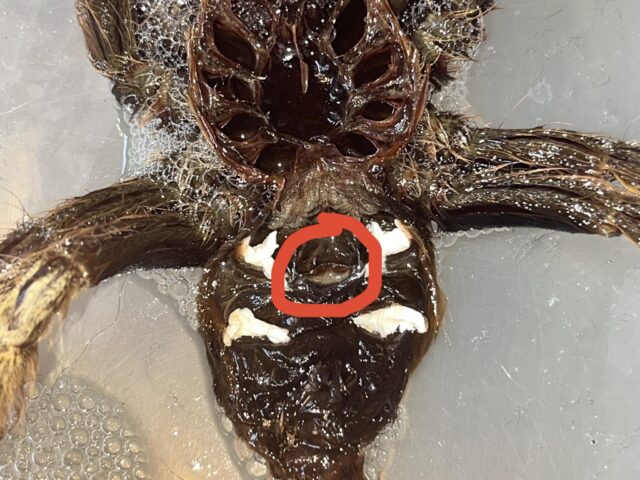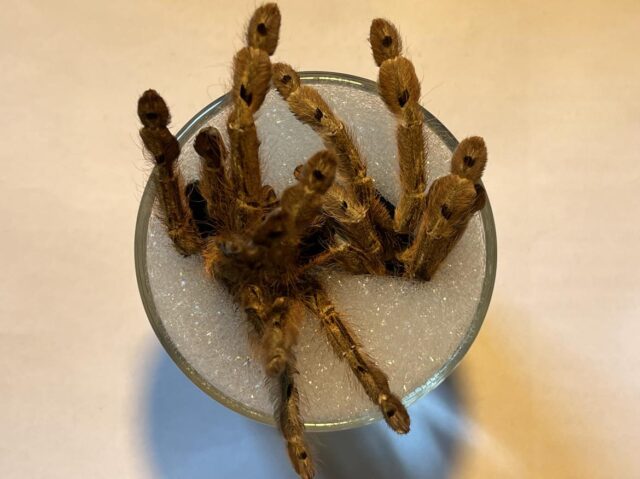Figuring out if your tarantula is male or female can be tricky. Examining its molt is the only reliable method to identify its gender. This guide will show you how to correctly sex your tarantula, ensuring accuracy.
Let’s get started!
Why Knowing Your Tarantula’s Gender is Important
Understanding if your tarantula is male or female impacts their care and breeding potential. Female tarantulas live longer, up to 2-3 times more than males, making them more valuable, especially for rare species.
Knowing the gender helps in planning for breeding as females have a spermatheca for sperm storing, crucial for successful mating. In contrast, males have a shorter life span; hence knowing their gender early allows breeders to mate them effectively within their limited time.
This knowledge ensures each tarantula receives appropriate care suited to its lifespan and reproductive needs while maximizing breeding opportunities.
Methods to Determine the Gender of a Tarantula
To find out if your tarantula is male or female, you can look at its molt or inspect it closely with a magnifier. These methods help reveal the spider’s gender by showing certain body features.
Examining the Molt
Examining the molt is Jamie’s Tarantulas’ recommended method for determining the gender of tarantulas. It provides accurate results for large, immature, or mature specimens.
- Wait for your tarantula to complete molting before attempting to retrieve the molt.
- Handle the molt carefully to avoid damage, as it’s critical for accurate sexing.
- Soften the molt in warm soapy water for 15-90 minutes to make examination easier.
- Look for a pronounced “flap” or spermathecae above the epigastric furrow on the inside of the molt; this indicates a female.
- Notice the absence of this feature suggests you have a male tarantula, especially in larger specimens.
- Practice makes perfect: regularly examine molts to improve your skill in identifying gender features accurately.
Through these steps, gender determination becomes an attainable task with each molting cycle of your tarantula.
Detailed Steps to Sex a Tarantula Using a Molt
To find out if your tarantula is male or female, look at its old skin after it molts. Search for the spermathecae in the molt to tell the gender.
Identifying the Spermathecae

Female Stromatopelma calceatum spermathecae
Finding the spermathecae is key in telling if a tarantula is female. This reproductive organ stores sperm until the tarantula lays eggs. Females have a noticeable “flap” above the epigastric furrow, known as spermathecae.
If you see this flap, it means the tarantula is female.
Male tarantulas lack this flap. So, spotting spermathecae confirms a female while its absence, especially in bigger spiders, usually points to a male. These structures can look different across species; some species might have two separate ones or just one big fused piece.
Seeing spermathecae means you’ve found a female tarantula.
Tips for Handling and Preparing for Sexing

To get ready for tarantula sexing, soften the molt in warm soapy water for 15-90 minutes. This makes examining it easier. Use magnification if the leg span is less than about 6cm to spot details like book lungs and female anatomy parts such as spermathecae.
Lay out the legs and gently open the abdominal skin to see everything clearly. Always practice on different molts to improve at determining gender.
Conclusion
Understanding this topic is very important in the hobby if we want to develop, make money, and even profit from selling unwanted males that are needed by others. A mature female is worth much more than the juvenile we purchased.
After all, the money earned in this way can be spent on acquiring new species and expanding the collection.
FAQs
1.What does a female tarantula look like?
Identifying a female tarantula can be challenging for someone unfamiliar with the subject, as most tarantulas reach large sizes regardless of their gender. The appearance, including size and color, is the main factor that allows distinguishing between two adult individuals. Females are simply more massive and more colorful.
2.What is the easiest way to sex a tarantula?
The easiest way to determine the gender of a tarantula is by opening its molt at the abdomen. Inside, there should be a spermatheca, indicating that it is a female.
3.How early can you sex a tarantula?
An experienced breeder, using a microscope, can determine the sex of a tarantula very early, even after the first few molts. Less experienced individuals, without specialized tools, must wait until the reproductive organs in the molt are visible to the naked eye.
4.How to sex a tarantula without molt?
The only effective way to determine the gender of a tarantula is by holding the tarantula in your hand or using tweezers and then gently opening the genital opening located at the junction of the carapace and abdomen. However, this method is for experienced breeders, as it requires knowledge of the specific species and involves the risk of injuring the spider or being bitten.
5.Do male and female tarantulas look the same?
Throughout their growth, males and females look identical. In many species, from a certain point, differences can be seen in the shape of the sexual plate. Males molt much faster than females. An adult male becomes more slender with longer legs, and in most species, he loses his vibrant colors, becoming more faded or gray. Mature male also has pedipalps.
6.Are female tarantulas more aggressive?
Depending on the species and many other factors, tarantulas can behave differently. Males behave the same before reaching maturity, but afterward, they no longer defend their burrow or their life as fiercely, as if they are focused solely on finding a mate for reproduction.







